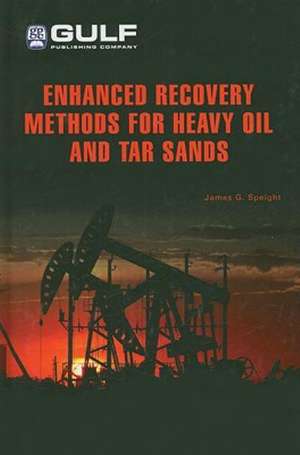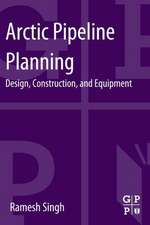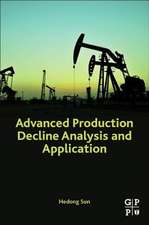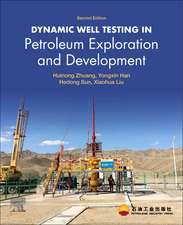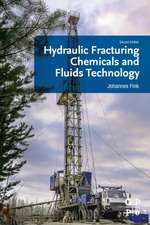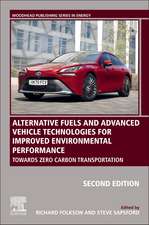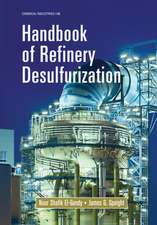Enhanced Recovery Methods for Heavy Oil and Tar Sands
Autor James G. Speighten Limba Engleză Hardback – iul 2009
Preț: 1024.22 lei
Preț vechi: 1403.04 lei
-27% Nou
Puncte Express: 1536
Preț estimativ în valută:
196.05€ • 213.02$ • 164.79£
196.05€ • 213.02$ • 164.79£
Carte tipărită la comandă
Livrare economică 21 aprilie-05 mai
Preluare comenzi: 021 569.72.76
Specificații
ISBN-13: 9781933762258
ISBN-10: 193376225X
Pagini: 354
Ilustrații: b/w illus
Dimensiuni: 152 x 229 x 25 mm
Greutate: 0.77 kg
Editura: ELSEVIER SCIENCE
ISBN-10: 193376225X
Pagini: 354
Ilustrații: b/w illus
Dimensiuni: 152 x 229 x 25 mm
Greutate: 0.77 kg
Editura: ELSEVIER SCIENCE
Cuprins
List of Figures
List of Tables
Preface
Chapter 1 Definitions
1.1 History
1.2 Petroleum
1.3 Heavy Oil
1.4 Tar Sand Bitumen
1.5 Validity of the Definitions
1.6 Conclusions
1.7 References
Chapter 2 Origin and Occurrence
2.1 Origin of Petroleum and Heavy Oil
2.1.1 Abiogenic Origin
2.1.2 Biogenic Origin
2.1.3 Occurrence and Distribution
2.2 Reservoirs
2.3 Reserves
2.3.1 Definitions
2.3.2 The Real Numbers
2.4 Production
2.5 Oil Pricing
2.5.1 Oil Price History
2.5.2 Pricing Strategies
2.5.3 The Role of Heavy Oil in the Future
2.6 References
Chapter 3 Reservoirs and Reservoir Fluids
3.1 Reservoirs
3.1.1 Structural Traps
3.1.2 Heterogeneity
3.2 Classes of Fluids
3.3 Evaluation of Reservoir Fluids
3.3.1 Sampling Methods
3.3.2 Data Acquisition and QA/QC
3.4 Physical (Bulk) Composition and Molecular Weight
3.4.1 Sampling
3.4.2 Asphaltene Separation
3.4.3 Fractionation
3.4.4 Molecular Weight
3.5 Reservoir Evaluation
3.6 References
Chapter 4 Properties
4.1 Physical Properties
4.1.1 Sampling
4.1.2 Elemental (Ultimate) Analysis
4.1.3 Metals Content
4.1.4 Density and Specific Gravity
4.1.5 Viscosity
4.2 Thermal Properties
4.2.1 Carbon Residue
4.2.2 Specific Heat
4.2.3 Heat of Combustion
4.2.4 Volatility
4.2.5 Liquefaction and Solidification
4.2.6 Solubility
4.3 Metals Content
4.4 References
Chapter 5 Exploration and General Methods for Oil Recovery
5.1 Exploration
5.2 Primary Recovery (Natural) Methods
5.3 Secondary Recovery
5.4 Enhanced Oil Recovery
5.4.1 Thermal Recovery Methods
5.4.2 Gas Flood Recovery Methods
5.4.3 Chemical Flood Recovery Methods
5.5 References
Chapter 6 Nonthermal Methods of Recovery
6.1 Primary Recovery (Natural) Methods
6.2 Secondary Recovery Methods
6.2.1 Waterflooding
6.2.2 Gas Injection
6.2.3 Cold Production
6.2.4 Pressure Pulse Technology
6.2.5 Solvent Processes
6.3 Enhanced Oil Recovery Methods
6.3.1 Alkaline Flooding
6.3.2 Carbon Dioxide Flooding
6.3.3 Cyclic Carbon Dioxide Stimulation
6.3.4 Nitrogen Flooding
6.3.5 Polymer Flooding
6.3.6 Micellar Polymer Flooding
6.3.7 Microbial Enhanced Oil Recovery
6.4 Oil Mining
6.5 References
Chapter 7 Thermal Methods of Recovery
7.1 Hot-Fluid Injection
7.2 Steam-Based Methods
7.2.1 Steam Drive Injection (Steam Injection)
7.2.2 Cyclic Steam Injection
7.2.3 Steam Drive
7.3 In Situ Combustion Processes
7.3.1 Forward Combustion
7.3.2 Reverse Combustion
7.3.3 The THAI Process
7.4 Other Processes
7.4.1 Horizontal Well Technology
7.4.2 Inert Gas Technology
7.4.3 Steam-Assisted Gravity Drainage (SAGD)
7.4.4 Hybrid Processes
7.5 In Situ Upgrading
7.6 References
Chapter 8 Upgrading Heavy Oil
8.1 Surface Upgrading
8.1.1 Thermal Cracking Processes
8.1.2 Catalytic Cracking Processes
8.1.3 Hydrogen Addition Processes
8.1.4 Solvent Processes
8.2 In Situ Upgrading
8.2.1 Solvent-Based Processes
8.2.2 Bulk Thermal Processes
8.3 References
App A Conversion Factors
Glossary
Index
